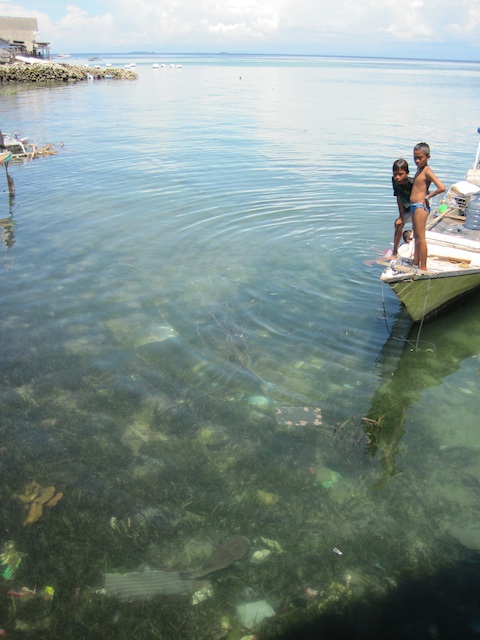Every fortnight we feature a seagrass meadow from around the world. This week, I thought I’d take a stab at writing about a recent trip I made to a seagrass meadow on a sand cay called Barang Lompo in South Sulawesi.
By Siti M. Yaakub (text) & Marjolijn Christianen (photos)
The Spermonde Archipelago is the stuff of seagrass legends. I say this because I’ve heard it talked about A LOT. The area has had a long succession of seagrass researchers (mostly Dutch) conducting their studies in the area. So when I got to tag along with Marjolijn (Mayo) and her two masters students Peter and Iris to visit some seagrasses off Makassar in South Sulawesi, I was pretty darn excited. We set off early from the hotel and after haggling for a boat, we set off for Barang Lompo, which is a coral island just north west of the town of Ujung Pandang in Makassar. In just under an hour (which is pretty impressive for our tiny vessel) we were there.
You know that feeling you get when you come across a seagrass meadow you haven’t been to before? You’re peering into the water, and you’re met with a carpet of awesome green, your heart leaps and you get tingles down your spine in anticipation of what you might find, and all you wanna do is jump right in and swim around like a crazed person checking off the number of species of seagrass you can find? That’s pretty much what happened.
The meadow didn’t disappoint, we spent a very happy hour or so exploring, ID-ing seagrass and checking out the cool critters going about their daily business.

The meadow was predominantly Enhalus acoroides, Halodule uninervis and Thalassia hemprichii with lots of Halophila ovalis in between.
After an hour or so of swimming, we were getting hungry, so we got back onto the boat and headed to a nearby island called Bono Batang to grab some lunch. Mayo was hoping to catch a glimpse of some turtles, but the tide was pretty low so chances of finding grazing turtles in the seagrass is pretty low.
When we got to the island, there was some excitement at the jetty. A couple of local boys had spotted a very large puffer fish in the seagrass surrounding the jetty and were taking turns diving in after it.
After lunch, we took a short stroll to a shop near the jetty, which turned out to be a souvenir shop – selling stuff collected from the sea. We had a quick chat with the owner and Mayo asked him about the occurrence of green turtles in the area, turns out there haven’t been green turtle sightings in decades! Lots of Hawksbills but no Greens 🙁

Mayo having a chat with the shop owner. Above her hands the skeleton of a dugong and hanging on the pillar to her right is a preserved turtle that's for sale to tourists.
When asked about the turtles he has for sale, the owner said that they are no longer allowed to catch turtles in the waters around the area and that the existing stock he has in his shop are all from before the new law was passed. We also learned that turtle meat is sometimes used as filler in local dishes because it’s cheaper than beef.
As we walked back to the jetty, we came across a rather disturbing sight. Marine rubbish was strewn everywhere along the shore. Turns out that there isn’t a proper waste disposal system on the island and it all goes into the sea. A sobering note to leave on, given that these islands are very densely populated. As we left you can actually see the impact marine litter is having on the seagrass beds just adjacent to the island. Will this be the fate of Barang Lompo as well?
————————————————————–











[…] it keeps raining articles where I am involved. This time my colleague from Singapore Siti Yaakub wrote up a story on a recent check of the seagrass near Makassar, Sulawesi. With my photo’s next to it. Enjoy it on the Seagrass Online site! Categories: paper, […]